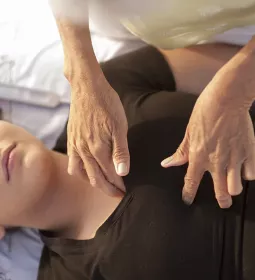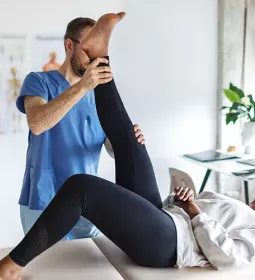Erik Dalton didn’t just advocate for using the sidelying position, he created a series of innovative sidelying techniques that empowers therapists to move beyond symptom relief and deliver transformative therapeutic experiences. He taught that sidelying enhances client comfort, improves therapist body mechanics, and enables more dynamic and precise technique application.
The sidelying position is ideal for clients who find it uncomfortable to lie prone or supine, such as pregnant people, older adults, or clients with certain spinal or respiratory issues. Often, clients who seek clinical bodywork are looking for relief from chronic pain, injuries, or biomechanical issues that make it impossible to receive therapy in a prone or supine position. With the presentation of low-back pain, for example, we may not have all the information related to a client’s underlying conditions. Particularly, when we see clients for the first session, using a sidelying position can make some techniques safer to receive (e.g., the client has spondylolisthesis). Dalton believed that well-trained practitioners can offer effective treatment to clients in any position that promotes client comfort.
Erik Dalton believed that well-trained practitioners can offer effective treatment to clients in any position that promotes client comfort.
Dalton also emphasized the importance of maintaining good body mechanics to prevent therapist injury and burnout. He developed his sidelying techniques focusing on optimal leverage and counterforce movements to allow therapists to work deeper with less effort.
For most therapists, however, the standout benefit of sidelying massage is the freedom it offers for movement and functional techniques. By positioning a client on their side, the therapist can easily mobilize joints and perform movement-based approaches. Therapists have access to the lateral structures of the body, including the iliotibial band, lateral hip rotators, and intercostal muscles. Sidelying also allows therapists to provide a movement-oriented approach when addressing shoulder and neck pain.
Sidelying Techniques
The methods I’ll share here are some of my favorites from Dalton’s extensive body of work. Organize a practice session with a willing massage colleague and try them. It’s just as important to experience these techniques as you apply them—you’ll value them more when you understand how effective and comfortable they feel.
Quadratus Lumborum (QL) Stretch (Image 1)
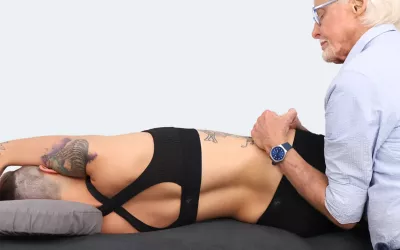
With the client on their left side, ask them to reach their right arm over their head to grasp the top of the therapy table. The client’s bottom knee is bent, and their top (right) leg is straight and extended slightly off the table. Stand behind the client and grasp their iliac crest while bracing their hips with your forearms. If you need a barrier between your body and the client’s body, place a pillow across the client’s hips and grasp around the pillow. Drop your weight back to traction the hip to release the QL and open the body’s lateral line, within the client’s level of comfort. Ask the client to pull up with the hand grasping the top of the table to a count of five and then relax. Repeat this technique three times and on the opposite side when you turn the client to their right side.
Windshield Wiper Technique (Image 2)
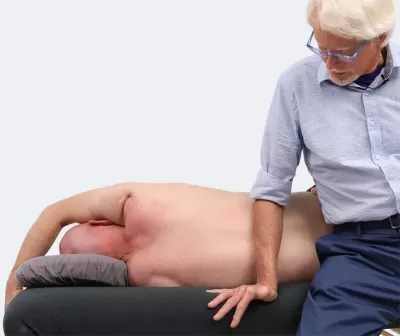
This technique is part of Dalton’s routine for the thoracic spine. With the client on their left side with their knees bent, sit on the table and grasp the client’s right hip with your left hand. Place your right palm on the table near the mid-back. Your right forearm hooks the lumbar tissue and sweeps toward the client’s head while your left hand braces the pelvis, creating a counterforce movement. Make 3–5 sweeps to decompress the thoracic spine and rib cage. Repeat this technique on the client’s opposite side.
Scrubbing the Facet Joints (Image 3)
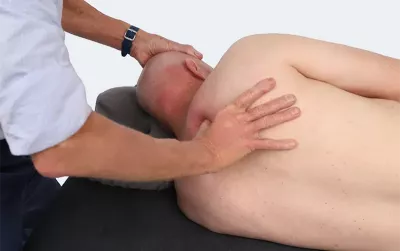
With the client on their left side and their knees bent, use your left hand to contact the client’s head. Place your right thumb in the lamina groove with moderate pressure. Flex the client’s head with your left hand while your right thumb presses toward their head, searching for tight spots that resist your thumb. When you find areas of resistance, drop your thumb into the tissue and compress it while you flex the client’s neck. Make several passes along the groove of the thoracic spine. Repeat this technique on the client’s opposite side.
Humeral Head Drop (Image 4)
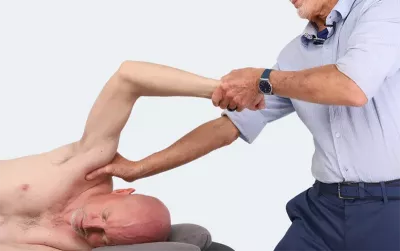
This technique is part of Dalton’s routine for addressing upper-crossed syndrome, deltoid shear, and rotator cuff injuries. It improves glenohumeral mobility. Stand at the head of the therapy table. With the client on their left side, lift their right arm by grasping their wrist with your left hand and bring the client’s arm into 90 degrees of abduction. With your right hand, cup the humeral head as shown.
Ask the client to gently pull their elbow toward their right hip while you resist; hold for a count of five, then relax. This gentle counterforce stretches the deltoid fascia and drops the humerus into the bottom part of the glenoid fossa. Apply this technique three times, so long as it doesn’t cause the client discomfort. Repeat the technique on the opposite arm when you turn the client to their right side.
Put It into Practice
I hope practicing a few new sidelying techniques feeds your enthusiasm for the sidelying position and encourages you to use more movement during sessions. While this position is essential to ensure comfort for some clients, it also enables dynamic technique application and transformative therapy.







